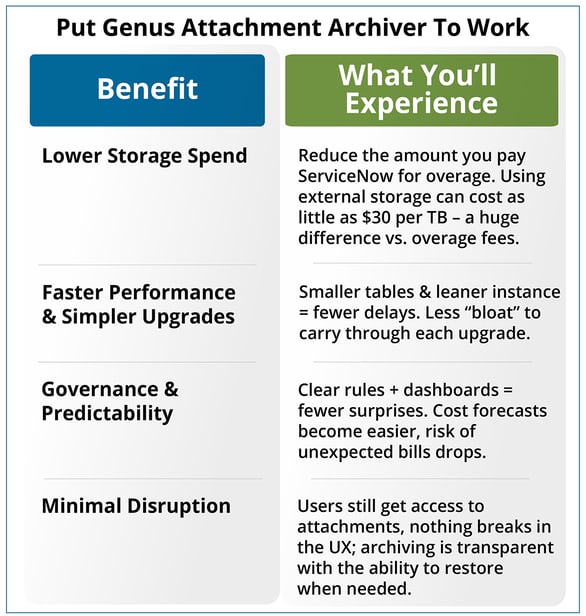Overview
- ServiceNow includes 4 TB of storage per instance, but attachments in tables like sys_attachment_doc often push environments past that limit.
- Overage fees can reach $1,700 per TB per month. This adds up quickly and also impacts performance, upgrade speed, and governance.
- Genus Attachment Archiver helps offload old or oversized attachments to lower-cost cloud storage like Azure, AWS, Google, Box, and Filenet, while keeping them accessible.
- It integrates directly with ServiceNow, supports automation, and gives you full visibility into what is archived and why.
Where are the Hidden Costs?
When you’re running a ServiceNow instance, you probably know the platform gives you 4 TB of free storage per instance. But what you might not realize is how quickly attachments – files, documents, images, logs stored in tables like sys_attachment and sys_attachment_doc – can blow past that limit.
Once you cross the threshold, every extra terabyte can cost hundreds or even thousands of dollars per month, slowing performance, complicating upgrades, and draining budgets without anyone noticing until the bill comes.
Here’s what I’ve observed in working with ServiceNow users, and what you can do about it, including how the Genus Attachment Archiver solves this problem without breaking your workflows.
What Many Customers Don't See Coming
-
Rising Storage Bills: Once you exceed the free 4 TB, additional storage can cost up to $1,700 per TB/month, depending on your account. Over a year, that adds up fast — especially when dozens of cases, projects, or users are adding attachments constantly.
-
Performance Degradation: More data equals more I/O, longer indexing, slower queries, and more “table bloat.” Users notice sluggish load times, reports take longer, and admins wrestle with maintenance windows.
-
Upgrade & Maintenance Complexity: Large instances with tens or hundreds of gigabytes of attachments make upgrades take longer, backups move more slowly, and sometimes risk failures or rollbacks.
- Governance & Visibility Gaps: Often, there’s no clear rule for which attachments stay, which can be removed or archived, or how old or large attachments contribute to costs. Without dashboards or analytics, attachments grow unchecked.
- Impaired Data Insights: When you try to stay under your attachment storage limit, you risk losing valuable context from early versions, change logs, or intermediate versions that often hide important patterns and intelligence.
Discover How to Get the Most Out of Your ServiceNow Investment!
How to Address the Problem: Strategy + Tooling
To rein in these hidden costs, you need two things:
1. A well-defined archiving policy – Decide:
- Which Attachments must stay in ServiceNow (recent, mission-critical, accessed frequently)
- Which can be archived (old, rarely accessed, very large)
- Criteria: age, size, type, etc.
2. Automation + external storage – Because manual cleanup is error-prone and doesn't scale.
That's where Genus Attachment Archiver comes in – it's built to give you both the policy and the mechanism.
Introducing Genus Attachment Archiver
Here’s what Genus Attachment Archiver offers and the parts that make a difference:
- Archive & restore attachments automatically or manually, based on rules you set. You can configure by case age, attachment size, or other criteria.
- External storage support: Azure, AWS, Google, Box, Filenet, etc. So, attachments live in lower-cost repositories yet remain retrievable whenever needed.
- Full visibility & control:
– Built-in dashboards and analytics for archived attachment volumes, trends, and costs.
– Logs of archive/unarchive operations.
– Flow Designer and JS API support so you can integrate archiving actions into your workflows.
- Low-friction setup:
– Requires a ServiceNow version of Washington, DC or later.
– You configure external repository access (e.g. a service account with write access to your bucket) and install the connector.
The Impact: What You Get When This Works Well
Using the Genus Attachment Archiver delivers several concrete benefits.

Getting Started: What to Check
If you're responsible for a ServiceNow environment, here are a few steps to start:
Take Control of Your Attachments
Attachments have a way of creeping up and costing more than you expect. Between overage fees, performance hits, upgrade delays, and unexpected use of storage, they’re a hidden drain on your ServiceNow investment.
The good news: with a clear policy and the right tool (like Genus Attachment Archiver), you can take control, lower your costs, improve performance, maintain access, and avoid surprises.
If you would like to see Genus Attachment Archiver in action, contact me – I’d be happy to walk you through a demo together. It’s often the small changes, done strategically, that deliver the biggest impact.
Explore Genus Attachment Archiver
As a longtime ServiceNow Registered Partner, Genus Technologies is committed to providing our customers with insights into innovative technologies that drive efficiency, productivity, and success. Subscribe to the Genus blog so you don't miss an article.

